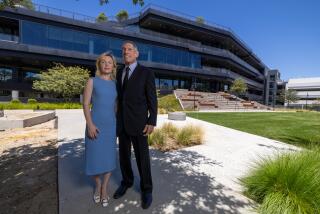Salk Defends Construction of Institute Annex : Architecture: The San Diego scientist says the expansion of the original structure, designed by Louis I. Kahn, is needed for research and offices.
- Share via
LA JOLLA — Imagine the Acropolis, or Stonehenge, being confronted by bulldozers. Imagine one of the 10 most important pieces of 20th-Century architecture being irrevocably damaged. Imagine being suitably outraged and having no one listen.
And if that wasn’t enough, imagine having as your adversary a renowned scientist who invented the vaccine for polio.
That’s the fix in which an elite corps of international architects say they find themselves, with nowhere to turn. At the center of this increasingly ugly controversy is the Salk Institute for Biological Studies, which San Diego architect J. Spencer Lake calls a work of poetry about to be interrupted.
“Many have compared it to the Acropolis in Greece and to Stonehenge in England,” Lake said.
And now?
“Its life as we know it is coming to an end,” he said, as if the building itself were being demolished, though some contend its spirit is.
The Salk Institute is being expanded. After years of planning, and after winning approval from the San Diego City Council and the California Coastal Commission, on Saturday the Salk Institute began construction of a 113,000-square-foot free-standing annex to the east of the renowned complex. If construction goes as planned, it will be completed in 1995.
Yet the project continues to draw protests from some of the country’s most gifted architects and preservationists, who are objecting to the placement of the addition designed by the San Francisco-based firm Anshen & Allen.
The list opposing the project reads like a Who’s Who of American architecture: James Ingo Freed, who designed the new Holocaust museum in Washington; Richard Meier, designer of the new J. Paul Getty Museum in Los Angeles; and Robert Venturi, among whose recent projects is a proposed redesign of the San Diego Museum of Contemporary Art in La Jolla. Richard Moe, the president of the National Trust for Historic Preservation, also bitterly opposes the expansion.
But they are well-matched in this battle: Their chief adversary is one of the world’s foremost scientists, Dr. Jonas Salk, who appears delighted by the change and by the additional space the institute will have for research and offices.
“Change can be for the better,” he said. “That’s what we see . . . that we’re trying to enhance and not diminish.”
The concrete-and-travertine complex leading to what appears to be the doorstep of the sky and the endless blue of the Pacific Ocean opened in 1962 as the product of a rare creative partnership between Salk and its architect, Louis I. Kahn, who died in 1974.
It is now largely in memory of Kahn that his children, as well as friends and admirers, have taken up the cause, which some concede may be a case of doing too little too late.
Salk says the expansion is desperately needed and that Kahn was well aware of the need for the so-called East Building when the institute was conceived around the time that John F. Kennedy became President.
Nathaniel Kahn, with his sister, Sue Ann Kahn, and their mother, Harriet Pattison, wants his father’s work to remain unscathed. Louis Kahn’s son also says Jonas Salk isn’t telling the truth.
“My father always said, ‘I want to be able to see the rising of the sun over the trees and the setting of the sun into the sea.’ And he wanted nothing to change that--ever,” Kahn said from his home in New York.
Los Angeles architect Stuart Emmons calls Kahn and Frank Lloyd Wright the century’s most important American architects, with the Salk Institute and the Kimbell Art Museum in Ft. Worth, Tex., as the legendary Kahn’s most illustrious creations. To compromise either, he said, would be to cheapen architecture itself.
A similar group previously thwarted attempts to expand the Kimbell. But this time, Emmons fears opposition arose too late, partly because “California was asleep at the wheel on this one,” and partly because the institute, in his view, sidestepped public input as deftly as it could--which Salk and his board of directors hotly deny.
As evidence of Emmons’ fears, the bulldozers have already stripped away almost an entire grove of eucalyptus trees that purists see as being as vital to the building--which has won countless international awards--as the stream that ripples through its open courtyard on a path to the sea.
“As you encountered the site (west of the UC San Diego campus), you came through this undefined, organic element--the grove--which I perceived as being like a forest . . . an abstraction,” architect Lake said. “Thus, you moved from the unmeasured world into the measured realm of science that the building itself symbolized.”
“If we try to dissect it in all these different ways, we begin to lose sight of the forest for the trees,” Salk said.
Still, Salk said he was sad to see that Kahn’s two adult children were among his fiercest opponents. Nathaniel Kahn, for one, says the decision to dig up the eucalyptus trees on a Saturday was evidence that the institute has done things in a “devious” way.
“I’m sorry for them. I’m sorry that they’re in pain,” Salk said. “But if we were to comply with their request (to move the expansion), it would be like relinquishing to them the continued creation of the institute.”
More to Read
The biggest entertainment stories
Get our big stories about Hollywood, film, television, music, arts, culture and more right in your inbox as soon as they publish.
You may occasionally receive promotional content from the Los Angeles Times.










